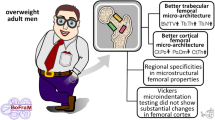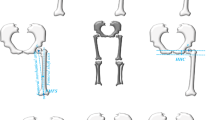Abstract
The objective of the present study is to compare distal femoral cartilage thicknesses of patients with occupational lead exposure with those of healthy subjects by using ultrasonography. A total of 48 male workers (a mean age of 34.8±6.8 years and mean body mass index (BMI) of 25.8±3.1 kg/m2) with a likely history of occupational lead exposure and age- and BMI-matched healthy male subjects were enrolled. Demographic and clinical characteristics of the patients, that is, age, weight, height, occupation, estimated duration of lead exposure, and smoking habits were recorded. Femoral cartilage thickness was assessed from the midpoints of right medial condyle (RMC), right lateral condyle (RLC), right intercondylar area (RIA), left medial condyle (LMC), left lateral condyle (LLC), and left intercondylar area (LIA) by using ultrasonography. Although the workers had higher femoral cartilage thickness values at all measurement sites when compared with those of the control subjects, the difference reached statistical significance at RLC (P=0.010), LMC (P=0.001), and LIA (P=0.039). There were no correlations between clinical parameters and cartilage-thickness values of the workers. Subjects with a history of lead exposure had higher femoral cartilage thickness as compared with the healthy subjects. Further studies, including histological evaluations, are awaited to clarify the clinical relevance of this increase in cartilage thickness and to explore the long-term follow-up especially with respect to osteoarthritis development.
This is a preview of subscription content, access via your institution
Access options
Subscribe to this journal
Receive 6 print issues and online access
$259.00 per year
only $43.17 per issue
Buy this article
- Purchase on Springer Link
- Instant access to full article PDF
Prices may be subject to local taxes which are calculated during checkout

Similar content being viewed by others
References
Flora G, Gupta D, Tiwari A . Toxicity of lead: a review with recent updates. Interdiscip Toxicol 2012: 5: 47–58.
Rosin A . The long-term consequences of exposure to lead. Isr Med Assoc J 2009: 11: 689–694.
Schwartz BS, Hu H . Adult lead exposure: time for change. Environ Health Perspect 2007: 115: 451–454.
Puzas JE, Sickel MJ, Felter ME . Osteoblasts and chondrocytes are important target cells for the toxic effects of lead. Neurotoxicology 1992: 13: 783–788.
Gonzales-Riola J, Hernandez ER, Escribano A, Revilla M, Seco Ca-, Villa LF et al. Effect of lead on bone and cartilage in sexually mature rats: a morphometric and histomorphometry study. Environ Res 1997: 74: 91–93.
Kalisińska E, Salicki W, Kavetska KM, Ligocki M . Trace metal concentrations are higher in cartilage than in bones of scaup and pochard wintering in Poland. Sci Total Environ 2007: 388: 90–103.
Carmouche JJ, Puzas JE, Zhang X, Tiyapatanaputi P, Cory-Slechta DA, Gelein R et al. Lead exposure inhibits fracture healing and is associated with increased chondrogenesis, delay in cartilage mineralization, and a decrease in osteoprogenitor frequency. Environ Health Perspect 2005: 113: 749–755.
Mathiesen O, Konradsen L, Torp-Pedersen S, Jorgensen U . Ultrasonography and articular cartilage defects in the knee: an in vitro evaluation of the accuracy of cartilage thickness and defect size assessment. Knee Surg Sports Traumatol Arthrosc 2004: 12: 440–443.
Lee CL, Huang MH, Chai CY, Chen CH, Su JY, Tien YC . The validity of in vivo ultrasonographic grading of osteoarthritic femoral condylar cartilage: a comparison with in vitro ultrasonographic and histologic gradings. Osteoarthritis Cartilage 2008: 16: 352–358.
Yoon CH, Kim HS, Ju JH, Jee WH, Park SH, Kim HY . Validity of the sonographic longitudinal sagittal image for assessment of the cartilage thickness in the knee osteoarthritis. Clin Rheumatol 2008: 27: 1507–1516.
Needleman H . Lead poisoning. Annu Rev Med 2004: 55: 209–222.
Escribano A, Revilla M, Hernandez ER, Seco C, Gonzalez- Riola J, Villa LF et al. Effect of lead on bone development and bone mass: a morphometric, densitometric, and histomorphometric study in growing rats. Calcif Tissue Int 1997: 60: 200–203.
Gruber HE, Gonick HC, Khalil-manesh F, Sanchez TV, Motsinger S, Meyer M et al. Osteopenia induced by long-term, low- and high-level exposure of the adult rat to lead. Miner Electrolyte Metab 1997: 23: 65–73.
Berglund M, Akesson A, Bjellerup P, Vahter M . Metal-bone interactions. Toxicol Lett 2000: 112-113: 219–225.
Nelson AE, Shi XA, Schwartz TA, Chen JC, Renner JB, Caldwell KL et al. Whole blood lead levels are associated with radiographic and symptomatic knee osteoarthritis: a cross-sectional analysis in the Johnston County Osteoarthritis Project. Arthritis Res Ther 2011: 13: R37.
Kwapuliński J, Mirosławski J, Wiechuła D, Jurkiewicz A, Tokarowski A . The femur capitulum as a biomarker of contamination due to indicating lead content in the air by participation of the other metals. Sci Total Environ 1995: 175: 57–64.
Milachowski KA . Investigation of ischaemic necrosis of the femoral head with trace elements. Int Orthop 1988: 12: 323–330.
Krachler M, Domej W, Irgolic KJ . Concentrations of trace elements in osteoarthritic knee-joint effusions. Biol Trace Elem Res 2000: 75: 253–263.
Shen G The role of type X collagen in facilitating and regulating endochondral ossification of articular cartilage. Orthod Craniofac Res 2005: 8: 11–17.
Qureshi HY, Ricci G, Zafarullah M . Smad signaling pathway is a pivotal component of tissue inhibitor of metalloproteinases- 3 regulation by transforming growth factor beta in human chondrocytes. Biochim Biophys Acta 2008: 1783: 1605–1612.
Kupcsik L, Stoddart MJ, Li Z, Benneker LM, Alini M . Improving chondrogenesis: potential and limitations of SOX9 gene transfer and mechanical stimulation for cartilage tissue engineering. Tissue Eng Part A 2010: 16: 1845–1855.
Zuscik MJ, Pateder DB, Puzas JE, Schwarz EM, Rosier RN, O'Keefe RJ . Lead alters parathyroid hormone-related peptide and transforming growth factor-beta1 effects and AP-1 and NF-kappaB signaling in chondrocytes. J Orthop Res 2002: 20: 811–818.
Hicks DG, O'Keefe RJ, Reynolds KJ, Cory-Slechta DA, Puzas JE, Judkins A et al. Effects of lead on growth plate chondrocyte phenotype. Toxicol Appl Pharmacol 1996: 140: 164–172.
Zuscik MJ, Puzas E, O’Keefe RJ, Sheu T, Holz JD, Schwarz EM et al. Pb exposure regulates a complex interplay of signaling pathways in articular chondrocytes that ultimately leads to phenotypic changes resembling osteoarthritis. J Soc Toxicol 2006: 90: S1.
Calvo E, Palacios I, Delgado E, Sánchez-Pernaute O, Largo R, Egido J et al. Histopathological correlation of cartilage swelling detected by magnetic resonance imaging in early experimental osteoarthritis. Osteoarthritis Cartilage 2004: 12: 878–886.
Herrero-Beaumont G, Slavin RE, Swedo J, Cartwright JJ, Viegas S, Custer EM . Lead arthritis and lead poisoning following bullet wounds: a clinicopathologic, ultrastructural, and microanalytic study of two cases. Hum Pathol 1988: 19: 223–235.
DeMartini J, Wilson A, Powell JS, Powell CS . Lead arthropathy and systemic lead poisoning from an intraarticular bullet. AJR Am J Roentgenol 2001: 176: 1144.
Harding NR, Lipton JF, Vigorita VJ, Bryk E . Experimental lead arthropathy: an animal model. J Trauma 1999: 47: 951–955.
Bolanos AA, Vigorita VJ, Meyerson RI, D’Ambrosio FG, Bryk E . Intra-articular histopathologic changes secondary to local lead intoxication in rabbit knee joints. J Trauma 1995: 38: 668–671.
Zoeger N, Roschger P, Hofstaetter JG, Jokubonis C, Pepponi G, Falkenberg G et al. Lead accumulation in tidemark of articular cartilage. Osteoarthritis Cartilage 2006: 14: 906–913.
Faber SC, Eckstein F, Lukasz S, Mühlbauer R, Hohe J, Englmeier KH et al. Gender differences in knee joint cartilage thickness, volume and articular surface areas: assessment with quantitative three-dimensional MR imaging. Skeletal Radiol 2001: 30: 144–150.
Author information
Authors and Affiliations
Corresponding author
Ethics declarations
Competing interests
The authors declare no conflict of interest.
Rights and permissions
About this article
Cite this article
Yıldızgören, M., Baki, A., Kara, M. et al. Ultrasonographic measurement of the femoral cartilage thickness in patients with occupational lead exposure. J Expo Sci Environ Epidemiol 25, 417–419 (2015). https://doi.org/10.1038/jes.2014.64
Received:
Revised:
Accepted:
Published:
Issue Date:
DOI: https://doi.org/10.1038/jes.2014.64
Keywords
This article is cited by
-
The effect of ferritin levels on distal femoral cartilage thickness in patients with beta thalassaemia major
Journal of Bone and Mineral Metabolism (2023)



